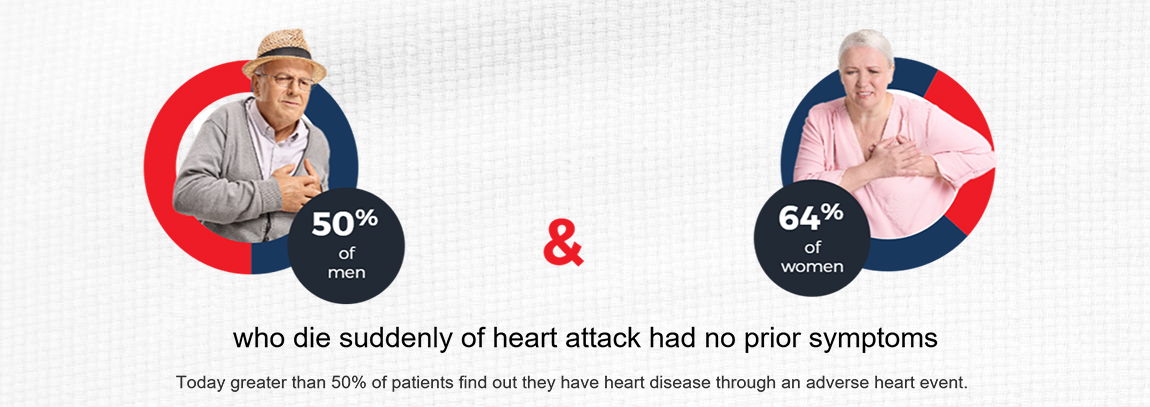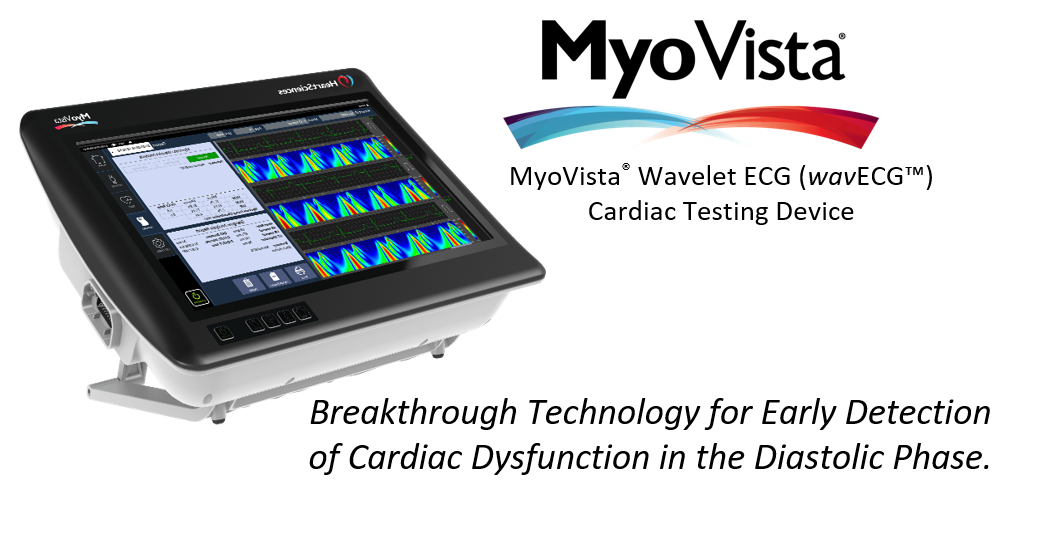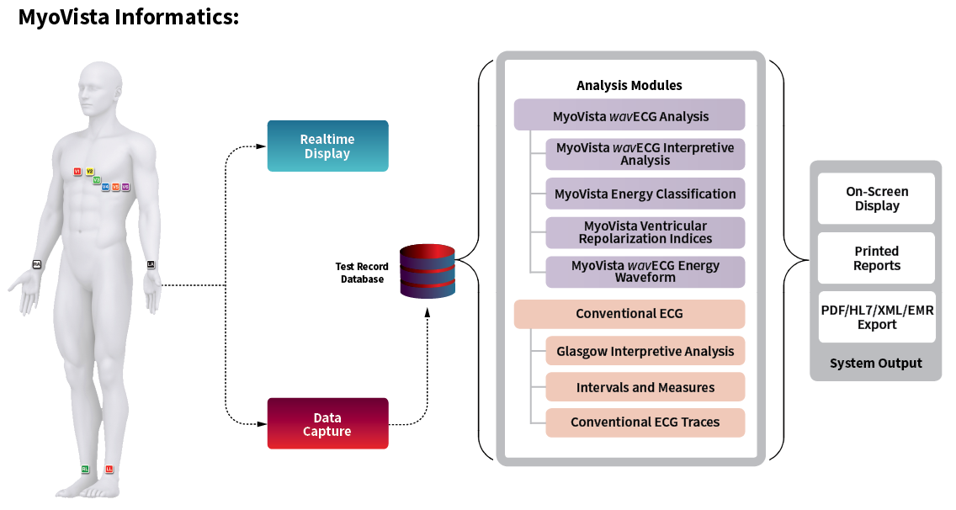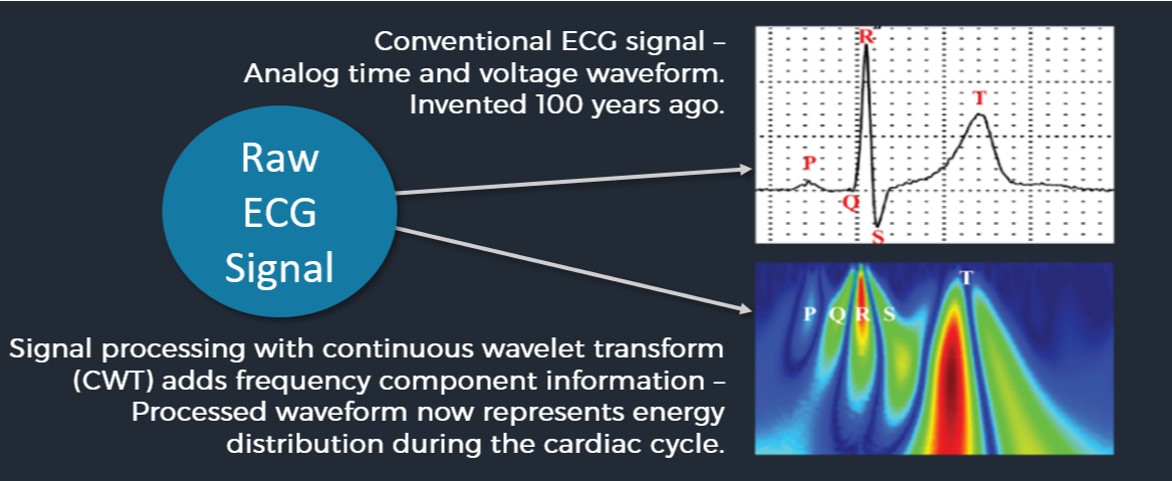


HeartSciences allows a front-line physician to detect heart disease much earlier. even in patients without symptoms.so that it can be treated before it's too late.
The weakness of conventional ECGs. results in a lack of effective frontline testing for early heart disease.
Because health system advise against using the ECG for early screening- most patients are not tested
Those same patients continue on unware until adverse event like a heart attack occurs 
Most patients with heart disease are asymptomatic.
Physicians have limited front-line technology options to detect heart disease.
Most advanced diagnostic tests are expensive and require referral.
Nuclear Stress; Echocardiogram, CT Angiogram, are expensive tests that are not used as front-line tools
Payors often discourage advanced diagnostics for asymptomatic patients


HeartSciences has developed a highly effective solution.
The MioVista® Wavelet ECG {wavECG™} :
Breakthrough. patented technology
Continuous wavelet transform (CWT) advanced signal processing
Artificial Intelligence
HeartSciences’ MyoVista wavECG Testing Device is a resting 12-lead electrocardiograph that incorporates Wavelet Signal Processing and is designed to improve the sensitivity of an ECG for detecting ischemic and structural heart disease. It’s patented advanced wavelet signal processing method measures myocardial energy during the cardiac cycle. New proprietary Informatics focus on cardiac performance and energy during repolarization that provide valuable new data to assist in the detection of cardiac relaxation abnormalities. MyoVista Testing provides all conventional resting 12-lead ECG information within the same test, at comparable cost, and follows the same lead placement protocol.

Conventional ECG's simply display voltage/time information. Technology that is over 100 years old. MyoVista uses Advanced Signal Processing and Artificial Intelligence to improve an ECG's ability to detect structural heart disease and coronary artery disease (CAD).

Artificial intelligence is applied to the MyoVista Technology to create algorithms to diagnose early structural and ischemic (CAD) heart disease - much earlier than is possible with a regular ECG.
Each MioVista Wavelet ECG Test also provides all conventional resting 12-lead ECG information to provide information on electrical rhythm problems like atrial fibrillation.



MyoVista wav ECG Technology provides breakthrough detection of structural and coronary heart disease at an early stage as well as providing all the conventional ECG information
The MyoVista wavECG Device utilizes continuous wavelet transform (CWT) based signal processing to extract significant additional frequency information from the acquired ECG signal which is then analyzed using artificial intelligence. Results of the wavECG LV Relaxation Algorithm provide information related to patient risk for left ventricular relaxation abnormalities associated with LVDD.
MyoVista wavECG Information has been developed to correlate to echocardiographic e-prime ('') and should be used in conjunction with other health-related patient information. Echo measurements of septal e < 7 cm/s or lateral e' < 10 cm/s are used as the criteria for abnormality in accordance with the ASE/AECVI guidelines for the evaluation of LV diastolic function in echocardiography.
The MyoVista wavECG Device has a high definition (1920 x 1080) touch screen that incorporates many easy and intuitive features commonly associated with a tablet device. The MyoVista wavECG Device follows conventional AHA/IEC resting 12-lead placement protocols, thereby minimizing training requirements


HeartSciences’ MyoVista® Wavelet ECG (wavECG™) Cardiac Testing Device is a new resting 12- lead electrocardiograph that uses continuous wavelet transform (CWT) signal processing to extract additional frequency information from the acquired ECG signal. This new information is a key aspect of the MyoVista wavECG AI-based algorithm that is designed to detect left ventricular (LV) relaxation abnormalities which are typically the earliest manifestation of left ventricular diastolic dysfunction (LVDD). Extensive research confirms that almost all forms and co-morbidities of heart disease are associated with LVDD including hypertension, diabetes, valvular disease, ischemia, and reduced systolic function.
The MyoVista wavECG Device is an innovative advancement for electrocardiographic testing designed to provide physicians with new information to improve patient risk- assessment related to cardiac dysfunction related to heart disease. This new wavECG LV Relaxation Algorithm Result information displays as either a “Highly Negative”, “Negative”
“Borderline”, “Positive” or “Highly Positive” result for LV relaxation abnormality. In conjunction with other health-related patient information this additional wavECG Information assists physicians in determining whether a patient should receive further testing, evaluation and/or treatment.
In addition to new wavECG Information, the MyoVista Device also provides all the information and capabilities of a full-featured conventional resting 12-lead ECG within the same test and follows the same clinical AHA/IEC lead placement protocol.
The MyoVista wavECG Device benefits from years of research and development by HeartSciences to improve the ability of an ECG to detect heart disease related to LV relaxation abnormalities.
HeartSciences' MyoVista Device is the world's first front-line.low-cost tool to enable accurate.early diagnosis of heart disease. It has the potential to save millions of lives and billions of healthcare system dollars.

MyoVista wavECG LV Relaxation Algorithm Result Statements The MyoVista wavECG LV Relaxation Algorithm is calculated using AI-based algorithms which incorporate data from the transformed ECG signal using continuous wavelet signal processing as well as conventional ECG information. The wavECG LV Relaxation Algorithm Result is provided in both indicator and statement form and displays the result as either “Highly Negative”, “Negative”, “Borderline”, “Positive” or “Highly Positive” for LV relaxation abnormality.

MyoVista LV Relaxation Indices The septal and lateral LV Relaxation Indices are components of the wavECG LV Relaxation Algorithm and are provided as secondary, supplemental information on septal e’ abnormality or lateral e’ abnormality individually. For each index, the further to the right (red) the number appears the greater the probability of either lateral or septal abnormal e’ and the further to the left (green) the number appears the lower the probability of either lateral or septal abnormal e’.

Provides conventional ECG trace information as well as the University of Glasgow 12-lead ECG Interpretive Analysis Algorithm and is regarded as one of the leading ECG analysis algorithms.
visit website : Click Here